
Agriculture faces mounting challenges, including climate change, soil degradation, pest infestations, and the growing demand for food due to a rapidly increasing population. To address these issues, scientists are turning to advanced genetic tools such as CRISPR (Clustered Regularly Interspaced Short Palindromic Repeats). This revolutionary gene-editing technology enables precise and targeted modifications in plant genomes, allowing breeders to develop improved crop varieties faster than traditional breeding methods.
CRISPR is not just a tool for scientific research—it is shaping the future of farming. From enhancing nutritional value to building climate resilience, its applications are paving the way for sustainable food production.
CRISPR technology functions like a molecular pair of scissors. It uses a guide RNA (gRNA) to identify a specific DNA sequence in the plant genome, and an enzyme, typically Cas9, cuts the DNA at that precise location. Once the DNA is cut, scientists can either disable a gene, insert a new gene, or make subtle changes to existing genetic sequences.
The precision of CRISPR allows researchers to make changes without affecting other parts of the genome, significantly reducing unintended side effects compared to older genetic engineering methods.
CRISPR can modify genes that regulate plant growth rate, flowering patterns, and nutrient efficiency. By tweaking these traits, scientists can develop varieties that produce higher yields without requiring more farmland or excessive fertilizer use. Even minor yield improvements can make a major difference in feeding a growing global population.
Crop losses due to fungal, bacterial, and viral infections cause significant economic damage each year. CRISPR enables the removal of genes that make plants susceptible to certain diseases or the enhancement of their natural immunity. This results in varieties that can withstand major pathogens, reducing the need for chemical treatments and lowering production costs.
Through precise DNA edits, CRISPR can increase the levels of essential vitamins, minerals, and proteins in staple crops like rice, maize, and wheat. Enhanced nutritional profiles can play a vital role in combating malnutrition, especially in regions where dietary diversity is limited.
With climate change bringing more extreme weather, there is an urgent need for crops that can survive under harsh conditions. CRISPR allows for the fine-tuning of stress-response genes so plants can conserve water, maintain photosynthesis, and continue producing yields even in prolonged droughts or heat waves.
By creating varieties that are resistant to pests and weeds, CRISPR can reduce the need for pesticides and herbicides. This lowers farming costs, reduces chemical residues in the environment, and supports a shift toward sustainable agricultural practices.
The next decade will likely see a surge in CRISPR-based agricultural innovations. Researchers are already working on multi-trait edited crops that combine disease resistance, climate resilience, and improved nutrition in a single variety. Additionally, CRISPR is being integrated with AI-driven genomic analysis to speed up the identification of beneficial genes.
With the right regulatory frameworks, public engagement, and continued research, CRISPR has the potential to revolutionize agriculture—ensuring that farmers can produce more food with fewer resources while safeguarding the environment.
CRISPR and other gene-editing technologies are powerful tools in the fight against global agricultural challenges. By enabling precise, fast, and cost-effective improvements in crops, CRISPR offers a pathway to a more sustainable future. However, careful implementation, transparent communication, and equitable access will be essential to ensure that its benefits reach farmers and consumers worldwide.
CRISPR is a gene-editing tool that allows scientists to make precise changes in a plant’s DNA. It works like molecular scissors, cutting specific genetic sequences so they can be removed, altered, or replaced. For more about crop models and simulations, see our CropSyst: Crop Simulation Model blog.
Traditional breeding involves crossing plants over multiple generations to introduce traits, which can take years. CRISPR enables targeted genetic changes in a much shorter time, without introducing unrelated traits. You can also read about NAAS-rated journals that cover advances in crop breeding.
Benefits include improved crop yields, enhanced resistance to pests and diseases, increased tolerance to climate stresses, and better nutritional content. Related: Environmental Impact Database (EI).
Yes. By developing pest- and disease-resistant crops, CRISPR can reduce the need for chemical pesticides, promoting more sustainable farming. Learn more about sustainable practices in our sustainable agriculture insights.
Regulations vary by country. In some places, CRISPR-edited crops that do not contain foreign DNA are not classified as GMOs, while others treat them similarly to traditional GMOs.
Crops edited with CRISPR undergo safety assessments before commercial release. The changes made are often similar to those that could occur naturally through mutations or selective breeding.
Yes. It can produce crops that tolerate drought, heat, salinity, and other climate stresses, helping farmers adapt to changing weather patterns.
Limitations include the need for specialized equipment and expertise, potential unintended genetic changes, and varying public acceptance across regions.
The timeline depends on the crop type, regulatory processes, and scale of field trials. It can range from a few years to over a decade.
Not entirely. CRISPR is a powerful tool but will likely complement traditional breeding and other biotechnologies to create improved crop varieties.
 NAAS Rating: 4.23
NAAS Rating: 4.23  October 2025 Issue
October 2025 Issue  Impact Factor: 6.69
Impact Factor: 6.69  Submit Article
Submit Article 
|
Citation Indices
|
All
|
Since 2020
|
|
Citation
|
6164
|
5117
|
|
h-index
|
31
|
29
|
|
i10-index
|
201
|
165
|
|
Acceptance Rate (By Year)
|
|
|
Year
|
Percentage
|
|
2024
|
11.09%
|
|
2023
|
15.23%
|
|
2022
|
12.81%
|
|
2021
|
10.45%
|
|
2020
|
9.6%
|
|
2019
|
14.3%
|
|
2018
|
17.65%
|
|
2017
|
16.9%
|
|
2016
|
22.9%
|
|
2015
|
26.1%
|